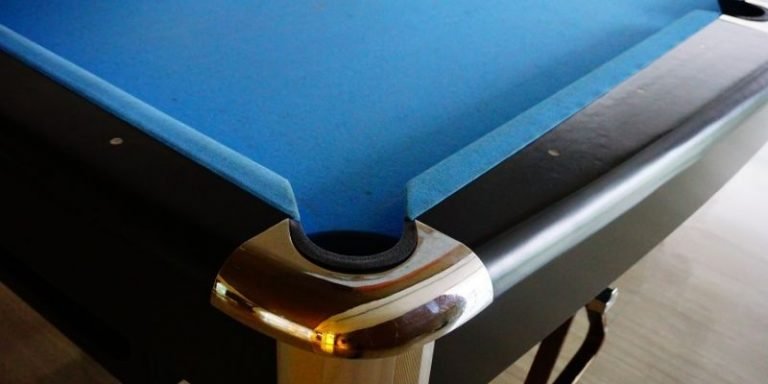Can You Patch Pool Table Felt? – A Comprehensive Guide

Pool tables are a centerpiece in many game rooms, clubs, and bars, offering endless entertainment and skillful play.
However, one common issue that arises with pool tables is the wear and tear of the felt surface.
This leads to an important question: Can you patch pool table felt?
The good news is you can repair pool table felt yourself with some patchwork. However, it can produce inconsistencies in the cloth around the repair job, which can affect the playability.
I will delve deeper into the intricacies of pool table felt repair, offering a detailed guide on how to patch and maintain your pool table felt for optimal performance and longevity.
Key Takeaways
- Understanding the feasibility and methods of patching pool table felt.
- Step-by-step guide on DIY felt repair.
- Tips for maintaining and extending the life of pool table felt.
Importance of Pool Table Felt Condition
The felt on a pool table, often overlooked, plays a pivotal role in the overall playing experience.
Its condition directly impacts not only the aesthetics of the table but, more importantly, the gameplay and longevity of the table itself.
Poor maintained playing cloth impacts things like:
- Ball Movement
- Speed
- Consistency
- Visual Appeal
- Wear and Tear
For more information on the best way to clean and maintain your pool table felt, check out my complete guide on the subject.
Assessing Felt Damage on Pool Tables?
Before any repair work, you should thoroughly assess the damage and determine:
- Is it fixable
- Is it worth repairing
Understanding the nature and extent of the damage helps in deciding whether a simple patch, a complete re-felting, or professional intervention is required.
The most common type of damage to a pool table’s felt is a cut or tear, which can be caused by anything from sharp objects, improper use, to accidents from jewelry getting caught.
Evaluating the Extent of Damage
- Size and Location: Small tears can often be patched, but larger ones might necessitate a full replacement. Large tears in the center of the cloth or along the rails is more concerning.
- Depth and Severity: Assess how deep the damage penetrates into the felt. Surface-level issues are generally easier to deal with than those that reach down to the slate.
- Overall Condition: Consider the age and general condition of the felt. If it’s already showing signs of wear and tear, patching might be a temporary solution before inevitable replacement.
Can You Flip Pool Table Felt?
The short answer is, yes, you can flip some types of pool table felt, but not all can be turned over and reused.
- Flipping worsted wool, is not advised because they usually only have one side designed to be played on.
- Flipping woolen cloth, will have less impact on gameplay due to the texture similarity on both sides of the cloth.
The smooth playing surface of worsted cloth is designed for speed, and usually can only be installed one way: the smooth side up.
Turning it over and using the fuzzier backside will be noticeable in the speed difference.
A lot of manufacturers, produce woolen felt that has similar, if not the same texture, on both sides of the fabric.
Because woolen cloth is a slower playing surface, flipping it can technically be done and has less effect on performance, if both sides of the cloth have a similar texture.
Repairing vs Replacement
Repairing the Pool Table Felt
Patching is a practical repair solution for minor damages and can be a cost-effective way to extend the life of your pool table felt. However, it’s important to consider the following:
- Type of Damage: Small tears, cuts, or burn marks are typically suitable for patching. The patch should be as inconspicuous as possible and not interfere with the roll of the balls.
- Aesthetics: A patch, even when well done, may still be visible. If the appearance of the table is a priority, particularly in a professional or upscale setting, patching might not be the best option.
- Skill Level Required: Patching requires a certain level of skill to ensure that the repair is smooth and does not affect the playability of the table. DIY patching is feasible, but might not match professional quality.
- Temporary Solution: Patching is often a temporary fix. Over time, the patched area may wear differently than the rest of the felt, potentially leading to future issues.
Replacing the Playing Cloth
Replacing the playing cloth is a more comprehensive solution and is often recommended in the following scenarios:
- Extensive Damage: If the felt has multiple areas of damage, significant fading, or extensive wear, patching may not be practical. In such cases, replacing the felt is the best option.
- Age and Wear: Over time, the felt loses its smoothness and elasticity. If the felt is old or has been heavily used, replacing it can rejuvenate the playing surface and improve the overall experience.
- Upgrading: If you’re looking to upgrade the quality of your felt (e.g., moving from a standard to a high-speed or tournament-grade cloth), replacing the entire felt is necessary.
- Consistency in Play: New felt provides a consistent playing surface. This is particularly important for serious players or in competitive settings where uniform playability is crucial.
How to Patch Pool Table Felt?
Patching pool table felt is a delicate process that requires precision and patience.
Whether you’re dealing with a small tear or a larger one, following these detailed steps can help you effectively repair the felt and extend the life of your pool table.
1. Assess the Damage
Identify the Area: Locate and carefully examine the damaged area. Assess the size and type of damage to determine if a patch is a viable solution.
Clean the Area: Ensure the damaged area is free of dust, debris, or any loose fibers. A clean surface is crucial for a successful patch.
2. Prepare the Patch Material
Select Matching Felt: Choose a piece of felt that closely matches the color and texture of your existing pool table felt. It’s often best to use felt from the same manufacturer.
Cut the Patch: Cut a piece of felt slightly larger than the damaged area. The extra size allows for better adhesion and a more seamless repair. Ideally, the patch should be about half an inch to an inch larger than the tear on all sides.
3. Apply the Adhesive
Choose the Right Adhesive: Select a fabric adhesive that is suitable for the felt material and won’t harden excessively, affecting the playability.
Apply Adhesive to the Patch: Apply a thin, even layer of adhesive to the back of the patch. Be careful not to over-apply, as excess glue can seep through the felt and create a hard spot on the playing surface.
4. Position and Attach the Patch
Align the Patch: Carefully align the patch over the damaged area, ensuring it’s perfectly flat and smooth.
Press Down Firmly: Once aligned, press down firmly on the patch to ensure good contact with the adhesive. Use a rolling pin or a similar tool to gently roll over the patch, ensuring there are no air bubbles or creases.
5. Allow Adequate Drying Time
Let It Dry: Follow the adhesive manufacturer’s recommendations for drying time. It’s crucial to allow the adhesive to fully cure to ensure a strong bond.
Avoid Disturbing the Patch: During the drying period, avoid using the table or disturbing the patched area.
6. Test the Repair
Inspect the Patch: Once dry, inspect the patch to ensure it’s securely attached and there are no raised edges or bumps.
Gently Test with Balls: Roll balls over the patched area to test the repair. The balls should roll smoothly without any deviation.
7. Final Touches
Trim Excess Felt: If there’s any excess felt around the edges of the patch, carefully trim it to match the level of the surrounding area.
Brush the Felt: Gently brush the felt around the patched area to blend it in with the rest of the table.
Repairing Larger Tears
For larger tears, the goal is to create a patch that is as seamless as possible.
This involves using a felt piece that perfectly matches the existing table felt in terms of texture and color.
- Cut the patch and the area around the tear with precision – Some professionals use a technique called ‘scarfing’, where the edges of both the patch and the tear are thinned out so that they can blend together more seamlessly.
- Use a high-quality adhesive – You will need an adhesive that is strong yet flexible. The adhesive should not harden the felt or alter its texture.
Color Matching
In cases where an exact color match is impossible, some professionals resort to dyeing the patch to match the existing felt.
This requires a deep understanding of fabric dyeing and should be approached with caution.
I don’t think I need to point out how hard it is to get the exact same seamless color.
If the existing felt has faded, sometimes the patch can be treated to mimic this fading, creating a more consistent look.
This is obviously difficult to achieve and if you have the budget, a new playing cloth is the best option.
Additional Tips
- Practice First: If you’re new to this, practice on a spare piece of felt to get a feel for the process.
- Be Patient: Rushing the process can lead to a less-than-ideal repair. Take your time for the best results.
- Seek Professional Advice: If unsure, consult with a professional before attempting the repair.
References
https://sewport.com/fabrics-directory/baize-fabric
https://poolfelt.com/pages/poolfelt-cloth-installation-guide







